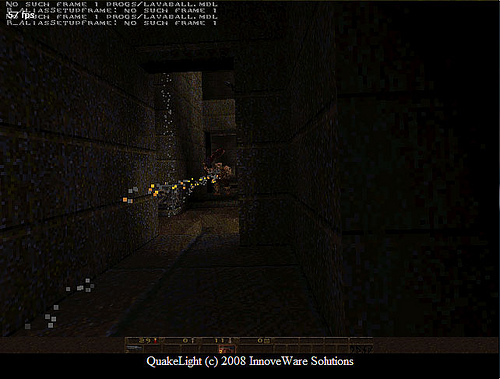 Thursday, 23 October 2008
Actually I know what it is ... it's a large code base, fully available, very graphical, and with reasonable performance demands. So many years ago, Vertigo ported Quake II to managed C++ to show how performant the app was and how easy it was to integrate something that is quick to do in managed code - a partially transparent bad-guy locator if I remember correctly. That was five years ago, before C++/CLI, so it was a thicket of underscores and general hard-to-read misery.
About a year ago, Greg Dolley did it to C++/CLI. And then in January of this year he did Quake III Arena.
Well, now Julien Frelat has done it in Silverlight! He was apparently inspired by someone who did it in Flash. This is Quake I, but he has plans for II. Adam Kinney has an interview and video.

What else can Quake be ported to?
Kate
 Wednesday, 22 October 2008
Rico, who like me wonders from time to time "am I old?", muses about how things tend to come on around again. Is C++ too old to bother learning now? Rico says no. But he also says:
...the real need facing C++ programmers is somewhat the same as what faced COBOL programmers say 25 years ago. It's not that the language is out of joint -- it isn't. I mean, ok maybe you like or don't like COBOL syntax but that doesn't doom a language and surely C++ syntax is not the zenith of wonderfulness. But that isn't what's holding C++ programmers back. The biggest problem, at least in my opinion, is one of accessing new/modern runtime features that may have a different programming environment from the context of an existing environment.
Now, what does that translate to in terms of action items for you? Good question.
Kate
 Tuesday, 21 October 2008
As you know if you attended the talks at Tech Ed USA and Tech Ed Europe, or listened to me on DotNetRocks, MFC now supports a Ribbon user interface. You can take some MFC application you haven't touched for a decade or more, add a few lines of code, leave all your command handlers and such untouched and -tada!- you can have a user interface from this century.
But it's one thing for me to demo for you what a tiny amount of code it takes to add a ribbon, and another for you to design a sensible ribbon that will lead your users effortlessly through your UI. Some guidance has now been released. For example, they are very clear that this is a bad ribbon:
.png)
There are tons of images and annotations to help you devise something your users will enjoy using. Please read it before doing any Ribbon work, whether in MFC or not.
Kate
 Monday, 20 October 2008
WPF lets you build truly beautiful user interfaces and user experiences. To do a good job, you need to think differently than a typical "grey boxes on a grey background" form based UI. Once you do that some ideas may come to you - wouldn't it be nice if you didn't have to write a lot of code to achieve the things you think up? Using effects is one way to jazz things up without doing it all yourself. Jaime Rodriguez blogged about the release of a library of effects on Codeplex. His blog includes still pictures, but really you need to see these on video. There's also a Channel 9 interview. Take a look and start to think about how users process information from your applications.

Kate
 Sunday, 19 October 2008
Word is starting to spread about the Vista Bridge. Greg Duncan's blog entry on it links to the SDK blog entry and includes a screenshot of the demo. Nice to see awareness growing on this. Interesting link on the side to a buzzword bingo game for Zune. I really need to take a few minutes and get some games onto my Zune to make those plane rides go a little faster...
Kate
 Saturday, 18 October 2008
Some schedules I have flagged with "must attend" in my calendar:
TL13 Microsoft Visual C++: 10 Is the New 6
Boris Jabes
Get more done. The next version of Visual C++ is all about improving developer productivity for large-scale applications. Learn about the IntelliSense and browsing experiences, changes to the project and build system, project-less browsing, collaboration through remote symbol indexing, and custom visualization of symbolic information.
Tags: Advanced, Languages
PC26 Microsoft Visual Studio: Building Applications with MFC
Damien Watkins
The next release of MFC will provide encapsulations around a number of new Windows platform features. With this functionality you can easily build applications that integrate into features such as desktop search, application restart and recovery functionality, leverage the new Windows UI metaphors such as Live Icons and Rich Preview. These features represent one of the most significant updates to MFC in years. Come learn the details on all these new classes so you can rapidly build Windows applications that stand out from the crowd.
Tags: Advanced, Visual Studio
TL25 Parallel Programming for C++ Developers in the Next Version of Microsoft Visual Studio
Rick Molloy
Build more responsive C++ programs that take full advantage of multicore hardware. We demonstrate how the new Parallel Pattern Library (PPL) enables you to express parallelism in your code and how the asynchronous messaging APIs can be used to separate shared state and increase your application's resilience and robustness. Finally, we take a look at some of the new capabilities of C++0x and Visual Studio to help you efficiently code and debug your multi-threaded applications.
Tags: Advanced, Parallelism, Visual Studio
Kate
 Friday, 17 October 2008
The concept of "a whole bunch of thingies" is a vital one in just about every programming language. Some languages support it right in the language itself. For example in C++ you can have an array of integers, or Employee objects, or Customer pointers. And when you use an array, you know that it's a continuous block of memory, and it's possible to interact either with just one element of the array or with the entire array. VB has arrays, and so does C#, and while the syntax is different between them, the essential concepts are not.
The thing is, an array is only the simplest and most accessible way to say "a whole bunch of thingies". It's important that you learn other ways to express that concept - typically by using a class of some sort that someone has written to represent it. There are a ton of these depending on whether order matters to you, does insertion speed matter more than traversing/iterating speed, and so on. Some folks, having learned one way to say "a whole bunch of thingies", look at all the other options, roll their eyes up into their heads, and stick with the one way they know.
This is bad. Not just because your code could be faster, neater, and easier to write, but also because arrays are really poorly suited for certain tasks. They especially hamper parallel programming - and you know that the future is concurrent, right?
Eric Lippert has written a cogent and compelling explanation of why arrays are rarely the right choice, and what you should do instead. It's written, naturally, from a C# perspective, but it's applicable to C++ and VB too. It boils down to this: Object Oriented Programming is the norm. Start trusting object writers. Use a class that someone else wrote and provided with your compiler, and you'll be a happier developer. And if you don't have some neurons fire over the phrase "considered harmful", here is a history lesson on that.
Kate
 Thursday, 16 October 2008
With every year that goes by, I of course get older. But I tend to feel older in bursts that are further than a year apart. Like when I first had a student in a class of mine who was born after 1977, which is the year I started university. Or when someone asked me where to get that special .NET utility "xcopy" so they could take advantage of "xcopy deployment". (Hint: it came in very very early versions of DOS. Pre Windows.)
But it turns out some technologies are not only older than when I started in this business, they're actually older than when I was born. Video games are 50, and I am not.

The circular inset shows an oscilloscope that was hacked up to let people play "tennis". But not like Pong, from above - this was from the side. From the CBC article:
Several weeks before the annual visitors' day in 1958, Higinbotham decided to liven things up. While reading through the instruction manual for one of the lab's analog computers, he found a description of how the machine could calculate ballistic missile trajectories.
With some minor programming modifications, he discovered that he could turn the ballistics demonstration into a manually-controlled game resembling tennis. Higinbotham had Dvorak hook up the computer to an oscilloscope, a five-inch screen used to display electric voltages, and add a pair of box-shaped controllers, each with a knob and a button.
The resultant game resembled a tennis court, as seen from the side. A horizontal line represented the court while a short vertical line in the middle was the net. Players could control the ball's direction and speed with the knob on the controller and hit it with the button.
"Tennis for Two," as it was dubbed, was a simple reworking of the analog computer's basic functions. To Higinbotham, it was no big deal.
"He didn't think there was anything new in there because he just used the circuits that were explained in the manual that came with the computer," says Peter Takacs, a physicist currently working in Brookhaven's instrumentation division. "He just took those circuits and figured out how to wire them together that would allow two people to hit a ball back and forth across the net. He didn't really think that was such an innovative thing."
Dvorak Jr. says the whole point of the game was to simply show off the capabilities of the hot new technology of the day.
"The whole idea was to show the public what a computer was, what it could do," he says. "From the perspective of society, he had no idea what he was doing."
Really cool.
Kate
© Copyright 2025 Kate Gregory
Theme design by Bryan Bell
newtelligence dasBlog 2.3.9074.18820   | Page rendered at Wednesday, 24 December 2025 04:38:27 (Eastern Standard Time, UTC-05:00)
|
On this page....
Pluralsight Free Trial
Search
Navigation
Categories
Blogroll
Sign In
|